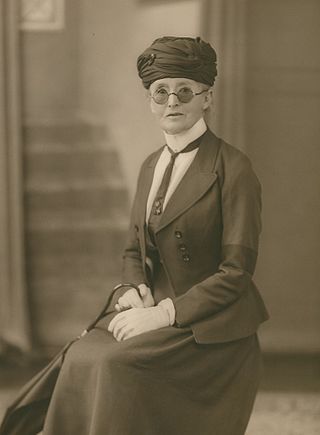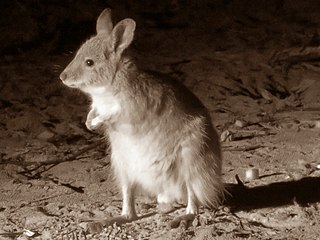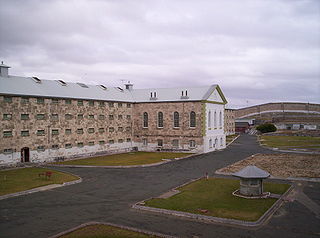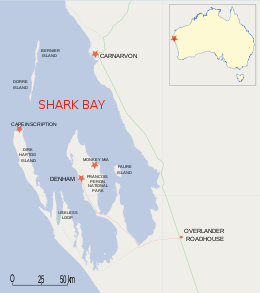
The Aboriginal Tasmanians are the Aboriginal people of the Australian island of Tasmania, located south of the mainland. At the time of European contact, Aboriginal Tasmanians were divided into a number of distinct ethnic groups. For much of the 20th century, the Tasmanian Aboriginal people were widely, and erroneously, thought of as extinct and intentionally exterminated by white settlers. Contemporary figures (2016) for the number of people of Tasmanian Aboriginal descent vary according to the criteria used to determine this identity, ranging from 6,000 to over 23,000.

Shark Bay is a World Heritage Site in the Gascoyne region of Western Australia. The 23,000-square-kilometre (8,900 sq mi) area is located approximately 800 kilometres (500 mi) north of Perth, on the westernmost point of the Australian continent.

Daisy May Bates, CBE was an Irish-Australian journalist, welfare worker and self-taught anthropologist who conducted fieldwork amongst several Indigenous nations in western and southern Australia.

The Contagious Diseases Acts were originally passed by the Parliament of the United Kingdom in 1864, with alterations and additions made in 1866 and 1869. In 1862, a committee had been established to inquire into venereal disease in the armed forces. On the committee's recommendation the first Contagious Diseases Act was passed. The legislation allowed police officers to arrest women suspected of being prostitutes in certain ports and army towns. Since there was no set definition of prostitution within the Act, the question was left to the police officer’s discretion, and women could be arrested even if there was no actual evidence of prostitution. The women were then subjected to compulsory physical examinations for venereal disease. If a woman was declared to be infected, she would be confined in what was known as a lock hospital until she recovered or her sentence was completed. Men suspected of frequenting prostitutes were not subjected to the same treatment of compulsory checks and confinement. The law was initially aimed at working-class women in towns near military bases, due to the concern that sexually transmitted infections were hampering Britain’s forces. The original act only applied to a few selected naval ports and army towns, but by 1869 the acts had been extended to cover eighteen "subjected districts".

Peel Island is a small heritage-listed island located in Moreton Bay, east of Brisbane, in South East Queensland, Australia. The island is a locality within the local government area of Redland City and a national park named Teerk Roo Ra National Park and Conservation Park.

Fantome Island is one of the islands in the Palm Island group. It is neighboured by Great Palm Island and is 65 km (40 mi) north-east of Townsville, Queensland on the east coast of Australia. The island is small with an area of 7.8 km2 (3.01 sq mi) and is surrounded by a fringing reef. The Djabugay (Aboriginal) name for this island is Eumilli Island.

The Western barred bandicoot, also known as the Shark Bay bandicoot or the Marl, is a small species of bandicoot; now extinct across most of its former range, the western barred bandicoot only survives on offshore islands and in fenced sanctuaries on the mainland.

The rufous hare-wallaby, also known as the mala, is a small macropod found in Australia. It was formerly widely distributed across the western half of the continent, but naturally occurring populations are now confined to Bernier Island and Dorre Island Islands off Western Australia.
This is a timeline of Aboriginal history of Western Australia.

Bernier Island is one of three islands that comprise the Bernier and Dorre Island Nature Reserve in the Shark Bay World Heritage area in Western Australia.

A lock hospital was an establishment that specialised in treating sexually transmitted diseases. They operated in Britain and its colonies and territories from the 18th century to the 20th.

Punishment in Australia arises when an individual has been accused or convicted of breaking the law through the Australian criminal justice system. Australia uses prisons, as well as community corrections. When awaiting trial, prisoners may be kept in specialised remand centres or within other prisons.

Channel Island is a suburb in the Middle Arm region of Darwin in the Northern Territory of Australia. It is located in the local government area of Litchfield. Channel Island Power Station and the Darwin Aquaculture Centre are located on the island.

Dorre Island is one of three islands that make up the Bernier and Dorre Island Nature Reserve in the Shark Bay World Heritage area in Western Australia. The island was named after Peter Dorre, the pilot of a Dutch vessel, the Eendracht, in 1616.

Indigenous health in Australia examines health and wellbeing indicators of Indigenous Australians compared with the rest of the population. Statistics indicate that Aboriginal Australians and Torres Strait Islanders are much less healthy than other Australians. Various government strategies have been put into place to try to remediate the problem; there has been some improvement in several areas, but statistics between Indigenous Australians and the rest of the Australian population still show unacceptable levels of difference.

Fantome Island Lock Hospital and Lazaret Sites is a heritage-listed former leper colony at Fantome Island, one of the Palm Island group in the Aboriginal Shire of Palm Island, Queensland, Australia. It was built from 1926 to 1945 by Queensland Government. It was added to the Queensland Heritage Register on 8 June 2012.

Taroom Aboriginal Settlement is a heritage-listed Aboriginal reserve at Bundulla, Taroom, Shire of Banana, Queensland, Australia. It was added to the Queensland Heritage Register on 13 May 2011. It is also known as Taroom Aboriginal Reserve and Taroom Aboriginal Mission.

The Chamberlain–Kahn Act of 1918 is a U.S. federal law passed on July 9, 1918, by the 65th United States Congress. The law implemented a public health program that came to be known as the American Plan, whose stated goal was to combat the spread of venereal disease.

Gladys Maud Sandes Alston was an Irish surgeon and venereologist and the first woman surgeon at the London Lock Hospital in 1925. Inspired by Elizabeth Garrett Anderson, she became an active member of the medical community and published widely on venereal diseases like syphilis and the treatment of children after sexual assault.

Palm Island Aboriginal Settlement, later officially known as Director of Native Affairs Office, Palm Island and also known as Palm Island Aboriginal Reserve, Palm Island mission and Palm Island Dormitory, was an Aboriginal reserve and penal settlement on Great Palm Island, the main island in the Palm Island group in North Queensland, Australia. It was the largest and most punitive reserve in Queensland.


















